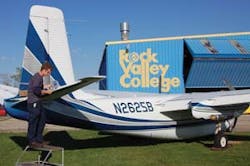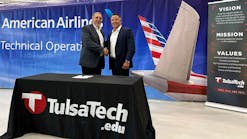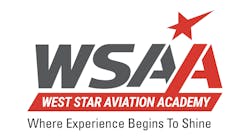Baby boomers, set that “Wayback Machine” to the days of your airframe and powerplant training. Remember all those advertisements in the trade publications? “With the current generation of aircraft mechanics retiring, there will be a huge shortage of qualified aircraft workers and a demand for thousands of new technicians in the next few years . . .” Well, that was for the retiring World War II-era guys.
Well, we’re seeing those ads again. But this time it’s us heading into the sunset contrails, making room for a new generation of aerospace industry technicians. Ironically, they’ll be facing similar challenges — high fuel prices, new technologies, global competition, corporate “right-sizing,” and an uncertain economy. But this next group is different than we were. They dress, talk, and learn differently, using social networking as their primary means of communication, rather than face-to-face conversation. And their A&P training, while still the basic curriculum of “1,900 hours covering the subjects as prescribed in Appendixes B, C, D, etc.” as specified in FAR Part 147, has become, by necessity, different. It’s created a challenge for them as students, for those who are responsible for their training and, of course, for their eventual employers.
Rock Valley College is a “typical” Midwest AMT program — a two-year college that started its program, like many others, back in the mid-1960s. For more than 40 years, RVC’s aviation maintenance technology program has consistently attracted, prepared, and placed high quality students.
Charles Billman is the current program coordinator. “I started here as a student in 1969 and the jet engine training I received prepared me for opportunities in the U.S. Navy after I graduated. That was before FAA Part 147 standardization in the early 1970s. Since then, there have been only minimal changes in the FAA-approved curriculum, even though industry standard and procedures have advanced drastically.”
There’s nothing new about the commitment that current A&P college students are required to make. They must attend classes for two years, at least five hours per day, five days a week almost year-round. That’s just to fulfill the contact hour requirements needed to take the FAA written, oral, and practical exams. But many of today’s students want more — at least an associate degree in applied science, requiring commitment in completing additional required college “gen-ed” courses. And many of them are planning for a bachelor’s degree, if not graduate school, in the future.
Students from all walks of life
RVC classes start in the sticky heat of mid-August, with freshmen students arriving at the big blue RVC hangar located at the Chicago Rockford International Airport. They come from all walks of life, and a variety of ages, backgrounds, genders, cultures, and experiences. Some are the more “traditional” recent high school graduates, unsure of their career path, making this program their first adult commitment.
Some, like Adam Wrenn were influenced by family members already in the aviation field. “My sister was in school to be an airline pilot and she convinced me to put my mechanical interests into aviation, which I always enjoyed anyway.” Tyler Bennett says, “My uncle and father took me to airshows every summer and that made me interested in how airplanes work.” Wes Evenson comes from a long line of mechanics as well: “I’ve always been fascinated by turbines.”
Other younger students may not have a family influence, but see aviation as an interesting career choice. Sam Hanson says, “The fact that aircraft are so complicated and interesting; it’s always been an idea of mine to learn about them.” Randy Rodriguez, the son of Mexican parents, agrees, “Airplanes have always interested me, especially WW II fighters.”
U.S. military veterans make up a significant portion of the freshman class as well. While some could obtain a sign-off based on their military experience, they know the importance of a college education in addition to the A&P certification. Cary Honor served in the U.S. Navy on an aircraft carrier. “I came back to my hometown school. Sometimes I feel stretched, but I realize it is for something better.”
Justin Ports was an Air Force crew chief on large transport aircraft. “My father is an A&P, so I grew up in civilian/military aviation. I juggle 30 to 40 hours of work each week and 25 hours in school, so study and class prep time is limited.”
The nontraditional student
Other students are more “non-traditional.” They include “older” students who are retraining after careers in other areas. Cynthia Evans has experience in a variety of fields including health care, the National Park Service, and as a certified sheet metal worker in the aviation industry. Pamela Ledford also has some aviation background. “I worked for Cessna Aircraft and found it to be rewarding and challenging. I find so much interest in being part of something so critical and big.”
Other “nontraditional” students include those who were victims of the downsizing of the automotive industry. Joe Brown explains, “When I lost my job at Chrysler I decided to find a new career in something I enjoy. Going to school full time has been very challenging. I have a wife, a child, and a mortgage to take care of and not being able to work full time has made things difficult.”
Shannon Anderson, another former automotive industry employee commutes each day from Wisconsin. “I like the idea of having a career in a solid field and the opportunity to get an associate degree along with my licenses. The class hours I spend put a burden on the time I spend with my family.”
Other students have traveled much further to get here. Vedran Grozdanovic’s family came to America from Bosnia. A second-year student, he has just a few weeks left before graduation. “I always knew I wanted to work with my hands. Between school, work, and personal responsibilities your schedule is pretty much filled seven days a week.”
Billman explains that the RVC program has traditionally been able to place just about all of its graduates within a few months of completion, once they get their licenses. After almost 30 years, Billman still enjoys his job. “The most important reward is seeing graduates succeed in the program and, more importantly in their aviation careers. Many of our graduates are working in supervisory positions throughout the aviation industry.”
Educational challenges
The educational process has its own unique set of challenges. Aircraft become more complex with new techniques.
Billman explains: “Students’ computer/electronic media skills have significantly improved and their expectations have advanced. Instructional changes have had to focus on the utilization of audiovisual and computerized technology and significant changes in how course content is presented such as Powerpoint, CBI, informational databases, FAA/manufacturers’ software, and use of the Internet.” Obtaining current components, equipment, and special tools is expensive for any program.
With the help of funding from the National Science Foundation (NSF), Billman and his NSF team have developed several computer-generated learning modules, including a turbine engine starting simulator which it has shared with a network of other A&P schools throughout the country.
Accreditation and transferring credits
And for the instructional staff there’s more to having a successful program than cutting-edge delivery methods and current equipment. In order for students to be able to transfer their credits to a four-year school, the program must be part of a college that has achieved national accreditation. Fortunately, Rock Valley College is not only accredited by the North Central Accreditation Association, it also is part of an statewide agreement with the other Illinois public colleges and universities that provides a seamless transition from a two-year to a four-year institution.
A student graduating with an associate degree will be accepted with junior-level status to any of Illinois’ four-year state institutions. This allows the RVC students who wish to pursue careers in engineering, business, education, or other fields to easily make that transition.
Todd Morgan, an RVC AMT faculty member, graduated from the RVC program, then went on to Southern Illinois University to earn a bachelor of science degree in its aviation program. He encourages his students to keep going after graduating from RVC because sometimes goals and opportunities change. “I can’t stress enough the need for higher education,” he says. “It just opens up so many possibilities that are not available with only an A&P license, when I first started my career in aviation with the Coast Guard I had no clue I would end up in the education field. Without a bachelor’s degree, I know I would not be in a career that I find so challenging and rewarding.” Graduates can also select private colleges and schools such as Embry-Riddle Aeronautical University, which has a branch campus in Rockford offering both undergraduate and graduate courses.
Advisory committee
Every vocational program benefits from the members of its advisory committee, often made up of former students and potential employers. Committee members offer valuable insight about current trends in the industry, both regarding maintenance practices and what graduates will be facing as they enter the “real world.”
Scott Crane is a member of the RVC AMT advisory committee and is an aircraft maintenance manager for UPS Airlines. He says, “We find the graduates from Rock Valley College and other similar programs to possess excellent skills that prepare them for careers in aviation. These skills, in combination with some fleet specific training, certainly provide all the necessary tools to be successful. We cannot understate the importance of advanced degrees, a high level of professionalism, and a keen focus on personal and operational safety, which is under ever-increasing emphasis. Our current and future AMTs are asked to do many things — professionalism, safety, and advanced skills are considered ‘required tools’ in today’s industry.”
George Leddy is the director of technical services for Flightcheck LLC, an employer of entry-level aviation technicians. He says, “Flightcheck has been very pleased with the basic knowledge and skill levels of the aircraft technicians from Rock Valley. Our company specializes in line maintenance, which requires the ability to make timely decisions while working within technical and regulatory requirements to keep our customers’ aircraft moving. Rock Valley prepares their graduates well for this environment.”
The upcoming crop of aviation technicians may not have heard of Mr. Peabody or perhaps can’t start the day without their personal communication devices, but they are confident in their abilities, know where they want to go, and are working hard to get there. This next generation will see a lot of changes and new opportunities that we can’t even imagine now. AMT
Scott Fisher is a Rock Valley College AMT faculty member. He received his A&P training from Dakota Aero Tech in Fargo, ND.



